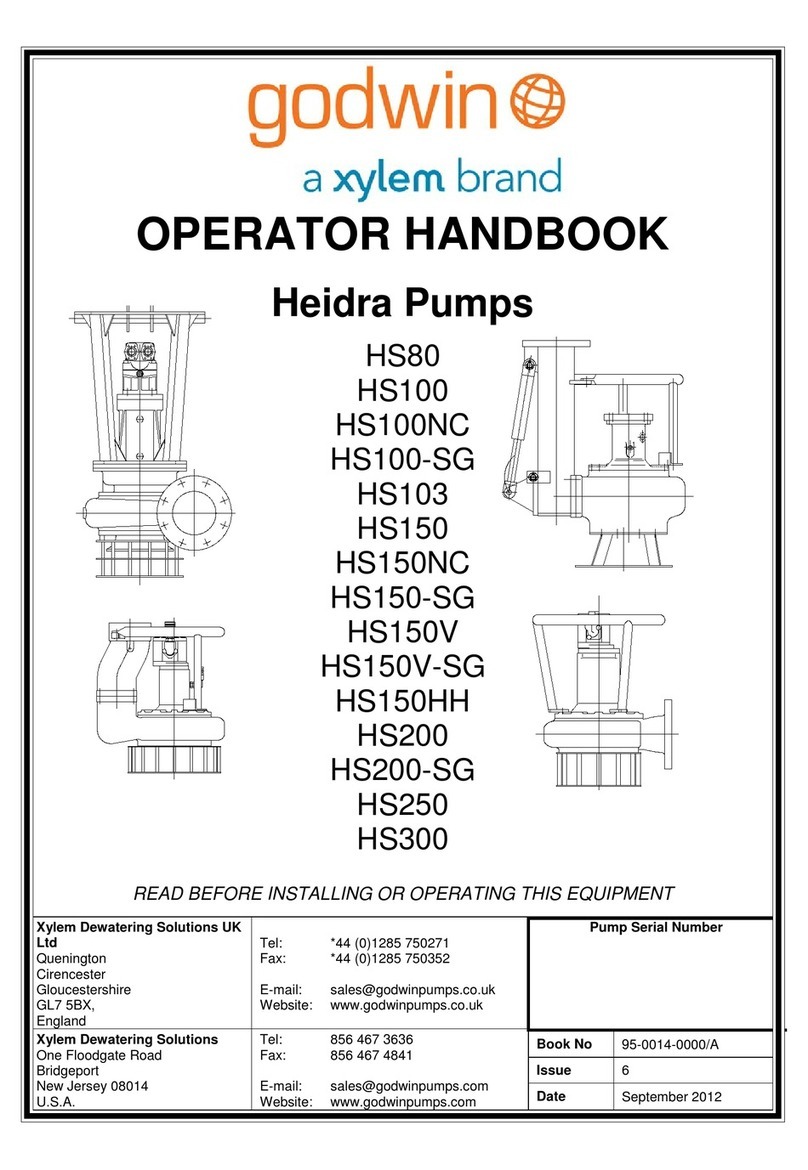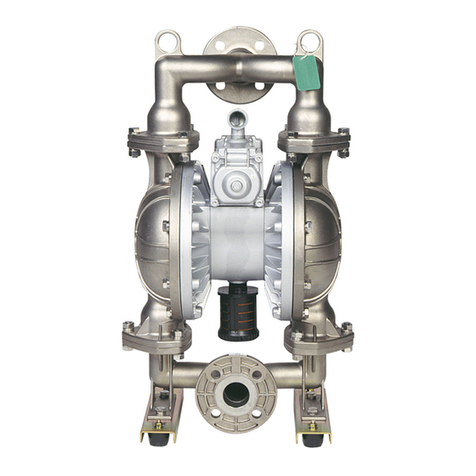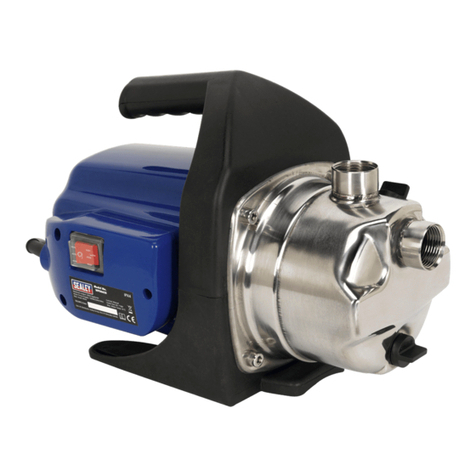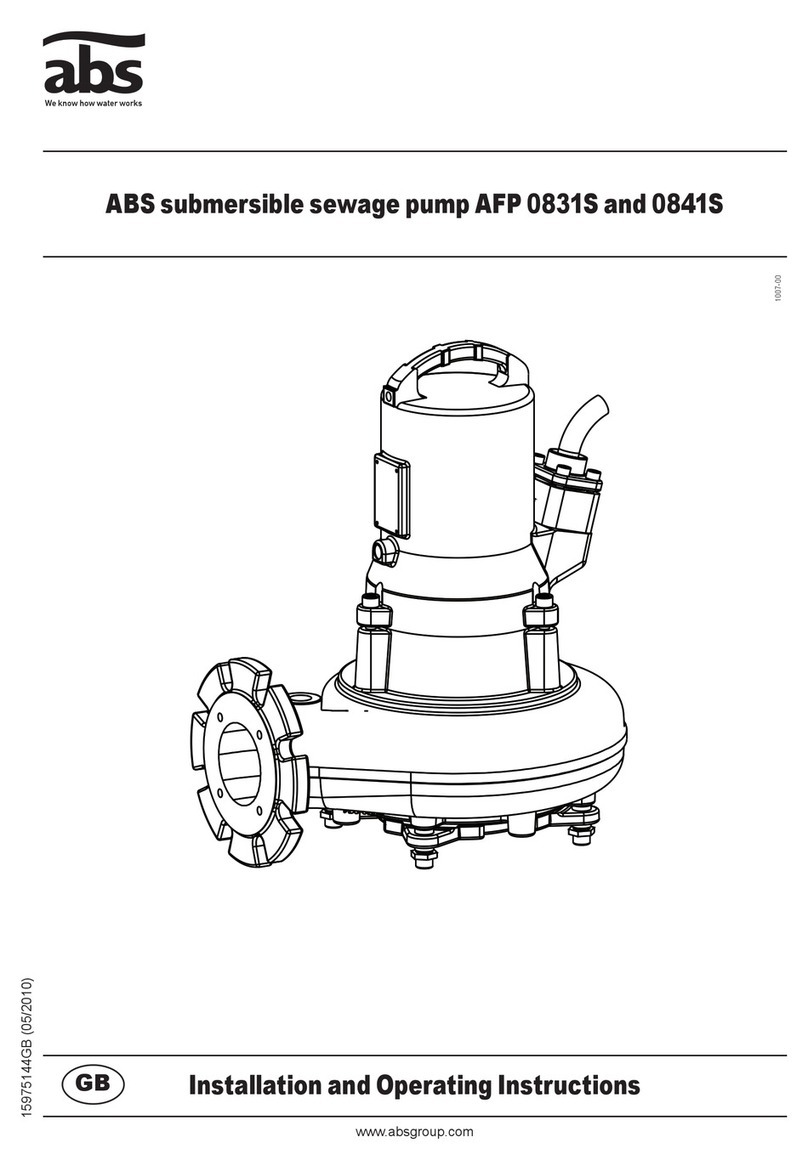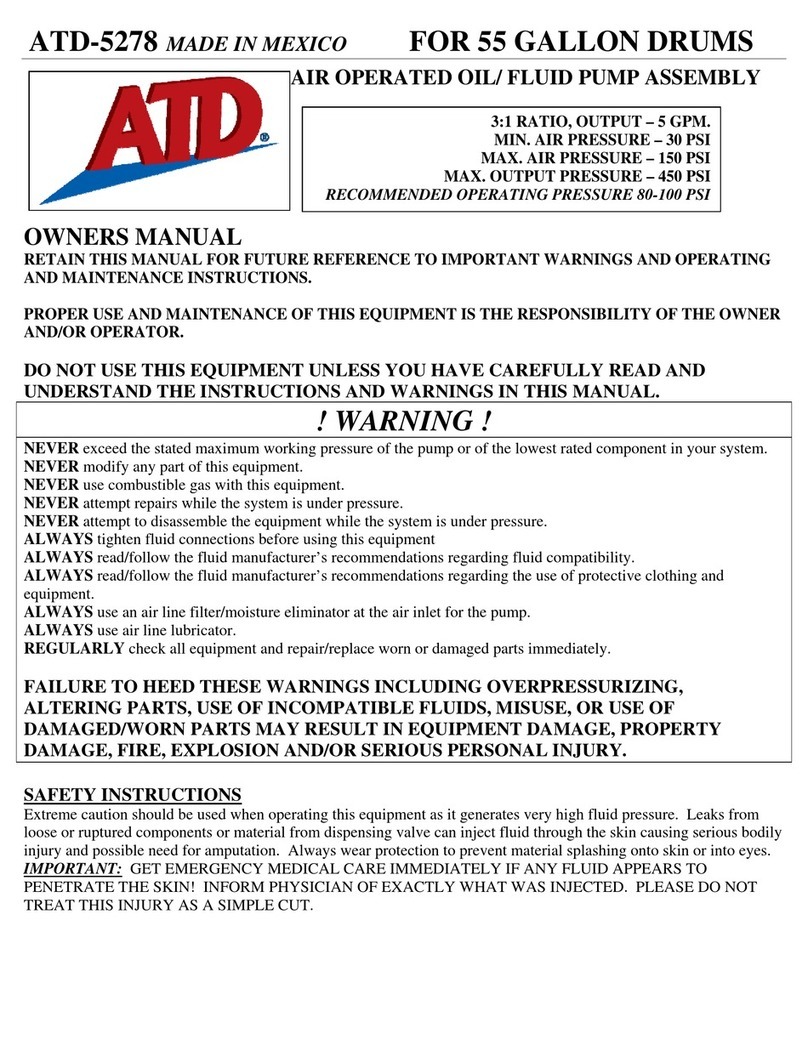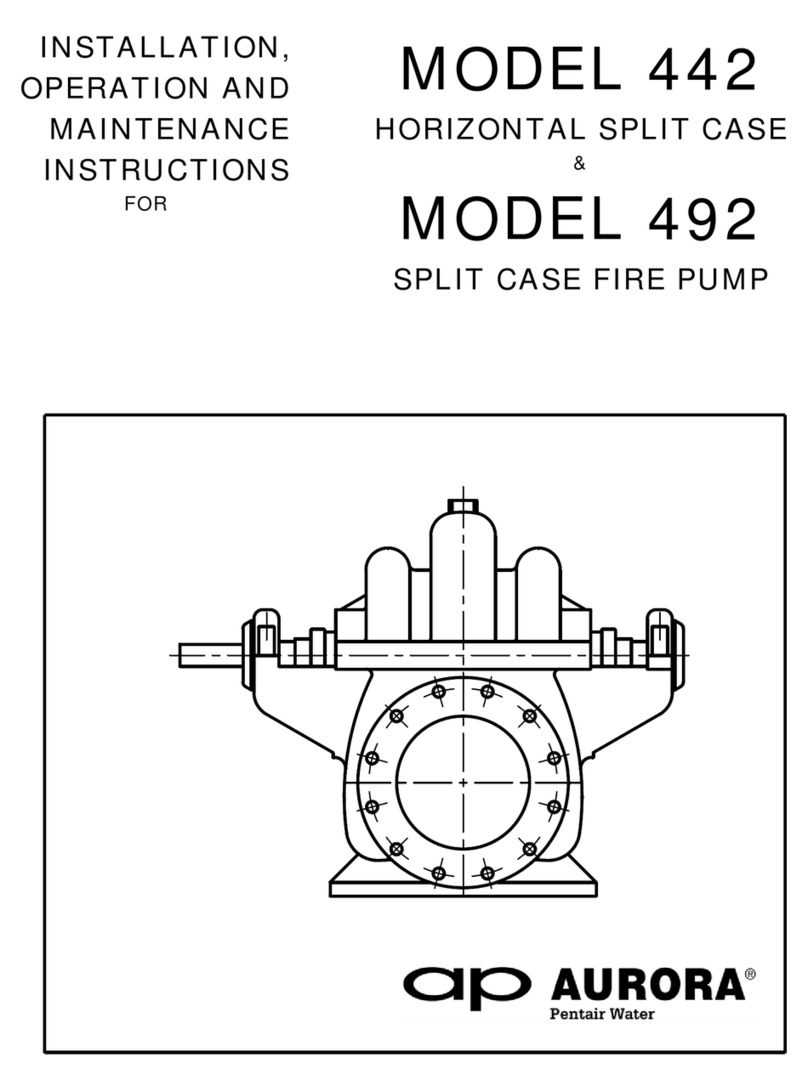Godwin Dri-Prime CD Series User manual

Installation, Operation and Maintenance Manual
CD, HL & NC Ranges
Dri-Prime®Pumps
Manual No. : 95-0019-0000 Issue : 12 Date : - Nov 2011
Pump Serial No.

Installation, Operation and Maintenance Manual
CD, HL & NC Ranges of Dri-Prime®Pumps
2 95-0019-0000 Iss 11
INDEX
1INTRODUCTION................................................................................................................................ 3
1.1 Manual Purpose .........................................................................................................................................................3
1.2 Information for the User, Operator or Maintenance Personnel. .................................................................................3
2WARRANTY....................................................................................................................................... 4
3HOW TO USE THIS MANUAL .......................................................................................................... 4
4SAFETY ............................................................................................................................................. 5
4.1 Lifting..........................................................................................................................................................................5
4.2 General.......................................................................................................................................................................6
5PUMP SERIAL NUMBER .................................................................................................................. 7
5.1 Spares........................................................................................................................................................................7
6INSTALLATION ................................................................................................................................. 7
6.1 Versions......................................................................................................................................................................7
6.1.1 Motor Adaptor..............................................................................................................................................7
6.1.2 Bearing Bracket...........................................................................................................................................7
6.2 Alignment....................................................................................................................................................................8
6.2.1 Alignment Procedure...................................................................................................................................8
6.3 General Installation Notes..........................................................................................................................................9
7OPERATION .................................................................................................................................... 10
7.1 General.....................................................................................................................................................................10
7.2 Flooded Suction........................................................................................................................................................10
7.3 Compressor/Vaccum pump disconnection...............................................................................................................10
7.4 Draining....................................................................................................................................................................11
8MAINTENANCE............................................................................................................................... 12
8.1 Bearings ...................................................................................................................................................................12
8.1.1 Re-greasing procedure..............................................................................................................................12
8.2 Seal coolant level .....................................................................................................................................................13
8.3 Seal removal.............................................................................................................................................................14
8.3.1 Front cover & pump body removal ............................................................................................................15
8.3.2 Removing the impeller...............................................................................................................................16
8.3.3 Removing the rear wear plate ...................................................................................................................18
8.4 Seal configuration.....................................................................................................................................................18
8.4.1 Removing the seal.....................................................................................................................................19
8.4.2 Inspection ..................................................................................................................................................19
8.5 Seal fitting.................................................................................................................................................................20
8.5.1 Preparation................................................................................................................................................20
8.5.2 Fitting the seal ...........................................................................................................................................20
8.5.3 Fitting the wear plate .................................................................................................................................23
8.5.4 Fitting the impeller.....................................................................................................................................24
8.5.5 Front cover & pump body fitting.................................................................................................................25
8.5.6 Preparing for service .................................................................................................................................25
8.6 Bearing Bracket & Motor Adaptor Dismantling.........................................................................................................26
8.6.1 Preparation for dismantling........................................................................................................................26
8.6.2 Dismantling................................................................................................................................................26
8.7 Bearing Bracket & Motor Adaptor Assembly............................................................................................................28
8.7.1 Preparation for assembly...........................................................................................................................28
8.7.2 Assembly...................................................................................................................................................28
8.8 Air Compressor.........................................................................................................................................................32
8.8.1 Filter Replacement ....................................................................................................................................32
8.9 Vacuum Pump..........................................................................................................................................................32
8.10 Non Return Valve.....................................................................................................................................................32
8.11 Drive Belts................................................................................................................................................................32
8.11.1 Timing/HTD Belt Replacement (air compressor)......................................................................................32
8.11.2 Belt Replacement (vacuum pump) ...........................................................................................................32
8.11.3 Link belt tensioning and replacement.......................................................................................................33
9TOOLS ............................................................................................................................................. 35
9.1 Tool Kits....................................................................................................................................................................35
9.2 Special Tools............................................................................................................................................................36
10 FAULT FINDING.............................................................................................................................. 36
11 TECHNICAL DATA.......................................................................................................................... 37
11.1 Designations, Sizes & Capacities.............................................................................................................................37
11.1.1 CD range ..................................................................................................................................................37
11.1.2 HL Range..................................................................................................................................................38
11.1.3 NC Range.................................................................................................................................................38
11.2 CD Range data.........................................................................................................................................................39
11.3 HL Range data .........................................................................................................................................................40
11.4 NC Range Data........................................................................................................................................................41
11.5 Spanner Torques......................................................................................................................................................42
11.6 Thread Locking Compounds ....................................................................................................................................42
11.7 Belt Tensioning.........................................................................................................................................................43
11.7.1 Force and deflection method....................................................................................................................43
11.7.2 Belt frequency method..............................................................................................................................43
11.7.3 Belt tension figures –HTD/Timing belts ....................................................................................................43
11.7.4 Belt tension figures Link............................................................................................................................43

Installation, Operation and Maintenance Manual
CD, HL & NC Ranges of Dri-Prime®Pumps
95-0019-0000 Iss 11 3
1 INTRODUCTION
1.1 Manual Purpose
This manual contains useful and important information to allow the pump to be properly installed, operated and maintained.
It also contains important instructions for preventing possible accidents and serious damage whilst carrying out those
activities.
Carefully read these instructions before commencing any of these activities.
The purpose of this Installation, Operating and Maintenance Manual is to provide the installer, owner or user of the
equipment with sufficient information to carry out those tasks for the CD, HL & NC ranges of Dri-Prime® Pumps.
Pump model designations covered by this manual are: -
CD75 HL80 NC80
CD80D HL100 NC100
CD80M HL110M NC150
CD100M HL125MS
CD103M HL150M
CD140M HL150MHD
CD150M HL200M
CD160M (Mk 1 & 2) HL130M
CD180M HL160M
CD200M HL225M
CD225 HL250M
CD250M HL260M
CD300M
CD400M
CD500M
The information contained in this manual was correct at the time of publication. It is subject to amendment at any time.
Should any doubt exist about the veracity of the information, contact Godwin Pumps Ltd for clarification before proceeding.
The pump may be supplied as a bare shaft pump end or packaged with a driver into a pump set. This manual covers the
pump end only. For packaged pump sets, information on equipment other than the pump end is contained in separate
documentation.
1.2 Information for the User, Operator or Maintenance Personnel.
Installation and maintenance is designed to be carried out using simple hand and service tools. A range of special tools
designed to ease dismantling and reassembly is available from Godwin Pumps Ltd. When the user has insufficient tools,
experience or ability, this work should not be attempted. Under no circumstances should makeshift tools or equipment be
used, as this may adversely affect safe working practices and pump operation.
Because of the number of different units covered by this manual, the user must ensure that they are reading the correct
instructions and viewing the correct diagrams for the unit they are working on.
Ensure that suitably qualified personnel carry out the installation. The variety of conditions and environments in which this
equipment can be used means that the operator and those responsible must satisfy themselves as to the safety and
acceptability of each application and operating condition of this equipment. Standard pumps are designed for use with
predominately clean or dirty water. For all other applications, including sea water, consult Godwin Pumps Ltd. Under no
circumstances will Godwin Pumps Ltd be responsible or liable for indirect or consequential damages arising from the use or
application of this equipment.
Parts that have not been approved by Godwin Pumps Ltd cannot be relied upon for correct material, dimensions or finish.
Godwin Pumps Ltd cannot therefore be held responsible for any damage arising from the use of such parts. This and failure
to observe any instruction or procedure in this manual will invalidate the warranty.

Installation, Operation and Maintenance Manual
CD, HL & NC Ranges of Dri-Prime®Pumps
4 95-0019-0000 Iss 11
2 WARRANTY
Unless special arrangements have been agreed and signed by both parties Godwin Pumps Ltd. will apply the following
policy over defects found after delivery.
We will make good, by repair or the supply of a replacement, defects which, under proper use, appear in the goods within a
period of twelve calendar months after the goods have been delivered (1) and arise solely from faulty design (other than a
design made, furnished or specified by you for which we have disclaimed responsibility in writing), materials or
workmanship: provided always that defective parts have been returned to us if we shall have so required. We shall refund
the cost of carriage on such returned parts and the repaired or new parts will be delivered by us free of charge.
Our liability under this clause shall be in lieu of any warranty or condition implied by law as to the quality or fitness for any
particular purpose of the goods, and save as provided in this clause we shall not be under any liability, whether in contract,
tort or otherwise, in respect of defects in goods delivered or for any injury (2), damage or loss resulting from such defects as
from any work done in connection therewith.
(1) For export orders, within a period of twelve calendar months after the goods have been delivered or, if delivery is
delayed by reason of customer instructions or lack of instructions, within a period of 18 months after the goods have
been notified as ready for despatch (whichever period expires the earlier).
(2) For UK orders, other than personal injury caused by our negligence as defined in Section 1 of the Unfair Contract
Terms Act, 1977.
3 HOW TO USE THIS MANUAL
Read this section before installing, operating or carrying out any maintenance on the unit.
When the pump is being installed operated or maintained there are a number of practices that may lead to personal injury or
product damage. Your attention is drawn to the following symbols and their meaning used throughout this manual.
used to identify mechanical hazards
used to identify electrical hazards
CAUTION
This caution symbol draws attention to special instructions or procedures which, if not correctly followed,
may result in damage to, or destruction of equipment.
WARNING
This warning symbol draws attention to special instructions or procedures which, if not strictly observed,
may result in personal injury.
WARNING
A WARNING SYMBOL WITH THIS TYPE OF TEXT DRAWS ATTENTION TO SPECIAL INSTRUCTIONS
OR PROCEDURES WHICH, IF NOT STRICTLY OBSERVED, MAY RESULT IN SEVERE PERSONAL
INJURY, OR LOSS OF LIFE.
NOTE: - A note is used to draw your attention to additional important information.

Installation, Operation and Maintenance Manual
CD, HL & NC Ranges of Dri-Prime®Pumps
95-0019-0000 Iss 11 5
4 SAFETY
WARNING
ALL ITEMS IN THIS SECTION, IF NOT STRICTLY OBSERVED, COULD RESULT IN SEVERE
PERSONAL INJURY OR LOSS OF LIFE.
4.1 Lifting
Use only lifting equipment of suitable capacity for the size and weight of the equipment being lifted
The equipment must always be lifted using safe working practices and in accordance with any local and national guidelines
or statutes. Figure 1, Figure 2, Figure 3 and Figure 4 show possible means of lifting. They are intended for guidance only. If
in doubt, consult Godwin Pumps Ltd or a local lifting expert.
Figure 1 Lifting smaller motor adaptor units Figure 2 Lifting smaller bearing bracket units
Figure 3 Typical lifting methods for close coupled bare shaft units (CD300M shown)
Figure 4 Typical lifting method for CD400 pumps
Whilst lifting the unit keep personnel well away and never allow people underneath.
CD100_02
CD225_02
HL100-02
HL100-04
CD400 LIFT

Installation, Operation and Maintenance Manual
CD, HL & NC Ranges of Dri-Prime®Pumps
6 95-0019-0000 Iss 11
4.2 General
Personnel working on the pump must always wear clean, correctly fitting clothing and safety footwear. Clothing impregnated
with oil or fuel can constitute a health hazard through prolonged contact with the skin and may also constitute a fire hazard.
Signs on the unit (e.g. directional arrows, maintenance and serial number plates & fluid connections, etc.) must be kept
clean and clear.
Check the type of liquid that the pump has been used for before carrying out any maintenance work. Residues could be
hazardous to your health. If in doubt, flush thoroughly with clean water before commencing work.
Rotating equipment presents a hazard in itself. Alert surrounding personnel before starting and post notifications whilst in
operation.
Moving parts are guarded to protect you. Guards removed for maintenance must be replaced before starting the pump.
Never insert anything into the pump body whilst the pump is running and the suction or delivery hoses are disconnected.
Use all flange bolt holes and ensure the correct bolt size and quality is utilised when connecting suction and delivery hoses.
Collapsible hoses must never be used on the suction side of the pump.
Keep the hose end suction area free from debris. Although the pump can handle solids up to the size indicated in the
Technical Data section of this manual, larger or irregular solids may cause blockage with damage to pump components.
Always allow adequate ventilation for the pump driver. Diesel engines require air for both combustion and cooling. Electric
motors require air for cooling purposes. This air must never be allowed to re-circulate.
Be aware of burn and fire risks from items such as exhaust pipes and silencers. Never place flammable items around the
unit.
Diesel engine exhaust and some of its constituents are known in the State of California to cause cancer, birth defects and
other reproductive harm.
Liquid pressure may still be present even after shutdown of the pump. Particular attention should be paid to delivery lines
that are long, or rise through any height, as these can contain large volumes of liquid. These lines must be isolated and
drained down before commencing work. Sudden release of this liquid can cause serious injury to an operator either directly
or indirectly through the rotational motion it can induce.

Installation, Operation and Maintenance Manual
CD, HL & NC Ranges of Dri-Prime®Pumps
95-0019-0000 Iss 11 7
5 PUMP SERIAL NUMBER
Every pump unit has a nameplate similar to one of those shown below. This nameplate lists the serial number and type of
the pump. These numbers must be quoted in any enquiry for spares or service.
Figure 5 Typical pump serial number plates
5.1 Spares
Use only genuine parts from your local Godwin Pumps Ltd supplier or distributor. Failure to do so may invalidate warranty
and/or reduce the pump’s working life.
6 INSTALLATION
All pumps in the range are designed to be run in one direction only. This is anti-clockwise when viewed from the suction
flange end or clockwise when viewed from the driving shaft end.
Rotation on electric motor driven pumps should be checked carefully – preferably with the coupling disconnected. On
installations where coupling disconnection is not possible apply power only for a brief instance, preferably with a soft start, in
order to determine rotation. A fast start or prolonged running in the wrong direction could cause parts to come loose.
CAUTION.
Failure to provide the correct rotation will give rise to poor performance, vibration and possible severe
damage to the pump.
6.1 Versions
Larger pumps (CD300/400/500 or HL130/160/225/250/260) can be supplied with or without an SAE adaptor fitted. With the
adaptor fitted they are suitable for direct coupling, without they are suitable for open coupling. The bearing bracket must be
adequately supported when used as open coupled units. If any doubt exists over the suitability of the support consult
Godwin Pumps Ltd.
Smaller pumps in the range are supplied as either motor adaptor or bearing bracket versions: -
6.1.1 Motor Adaptor
Motor adaptor (MA) versions of the pump are designed for close coupling to a suitable driver, usually a diesel engine. They
are supplied with transport feet that must be removed before attachment to the driver. Alignment of the pump to driver will
be taken care of by the flanged adaptor.
6.1.2 Bearing Bracket
Bearing bracket (BB) versions of the pump are designed for open coupling with the bearing bracket supported from the
same base but standing independently of the driver.
Correct alignment is critical for the longevity of the pump bearings, coupling and driver bearings. Follow the coupling
manufacturers’ instructions exactly.
See Section 6.2 for recommendations on alignment.

Installation, Operation and Maintenance Manual
CD, HL & NC Ranges of Dri-Prime®Pumps
8 95-0019-0000 Iss 11
Pump Driver
Parallel alignment.wmf
Pump Driver
A
ngular alignment.wmf
6.2 Alignment
The following notes provide general guidance on alignment and its elimination.
It is normal practice to carry out any adjustment to alignment by moving the driver – not the pump. In designing any
structure to support the pump set allow an additional 0.25mm (0.010”) extra height difference between pump and driver
support for shimming purposes.
There are two forms of misalignment – parallel and angular. Both must be less than the coupling manufacturers’ guidelines
in order for the coupling and bearings to give long and trouble free operation.
It is essential that the baseplate or support structure be fully tightened down before commencing any alignment procedures.
This will ensure that no misalignment is introduced by support structure deformation.
Alignment must always be carried out before any pipework is attached to the pump. Keep a note of the actual figures. Carry
out a check after the pipework has been attached and compare the figures. Any discrepancy must have been introduced by
the pipework attachment and must be corrected by refitting the pipework before putting the pump into service.
CAUTION.
Incorrect coupling alignment will lead to premature bearing and /or coupling failure.
6.2.1 Alignment Procedure
Roughly align the pump and driver by eye.
a) Parallel alignment
Mount a dial gauge on the driver shaft with the gauge running on the outer-machined
diameter of the pump coupling (see Figure 6). If the driver shaft is not accessible then the dial
gauge can be mounted on the driver coupling.
Turn the driver shaft, note the total indicator reading, and adjust the driver position
accordingly. Recheck.
Figure 6 Initial parallel alignment check
b) Angular alignment
Mount the dial gauge on the driver shaft or coupling (as for step a)) and adjust the dial
gauge to run on a mating face of the coupling as close to the outer diameter as
possible (see Figure 7).
Turn the driver shaft, note the total indicator reading, and adjust the driver in the
direction required. Recheck.
Figure 7 Angular alignment check
c) Confirming parallel alignment
Mount a dial gauge on the pump shaft with the gauge running on the outer-machined
diameter of the driver coupling (see Figure 8). If the pump shaft is not accessible then
the dial gauge can be mounted on the pump coupling provided the mounting face is
concentric with the shaft.
Turn the pump shaft and note the total indicator reading. Adjust the driver in the
direction required and recheck.
Figure 8 Secondary parallel alignment check
After alignment the pump and driver should be fully tightened down and the alignment rechecked to ensure that nothing has
moved in the tightening down procedure.
If a dial gauge is not available, then vernier callipers (or a taper gauge) and a straight edge can be used, providing the
coupling is of a type that permits it.
Measure the gap between coupling faces with the vernier callipers (or taper gauge) at four points equidistant around the
circumference of the coupling. Adjust until all are equal.
Use a straight edge across both machined outer diameters of the coupling at four points equidistant around the
circumference to confirm parallel alignment.
Pump Driver
Parallel ali
g
nment 1 .wmf

Installation, Operation and Maintenance Manual
CD, HL & NC Ranges of Dri-Prime®Pumps
95-0019-0000 Iss 11 9
Hose line recommendations
6.3 General Installation Notes
Godwin Pumps Ltd. may refute warranty liability if the installation does not meet the requirements of the pump. Should any
doubt exist as to the suitability of an installation, then Godwin Pumps Ltd. should be consulted.
Only suitably qualified personnel (both mechanical and electrical) should carry out the installation. All local and national
regulations in force must be observed.
The coupling used to connect the driver and pump must have the correct characteristics for the purpose. If in doubt –consult
Godwin Pumps Ltd.
The completed pump set must be mounted on a firm level surface.
On bare shaft pumps guarding of the belts, pulleys and couplings is the responsibility of the installer.
Pump sets are supplied with guarding to meet general applicable standards but site conditions may necessitate further
measures such as railings or screens. These are also the responsibility of the installer.
The Godwin Dri-Prime pump range is designed to operate on long lengths of suction pipe but it is always advisable to
position the pump as close to the source as possible.
The Godwin Dri-Prime product is designed to handle small amounts of air leakage, but to ensure optimum pump
performance, it is advisable to ensure that the suction pipe work is airtight and the end is sufficiently submerged to prevent
air being drawn into the pipe.
A general-purpose strainer should be fitted to the end of the suction pipe work and the total area of the openings should be
at least three times the normal area of the suction pipe work. Strainer apertures should be no greater than the maximum
recommended solids handling size for the pump.
The suction and delivery pipe work should be kept as short as possible with a minimum number of large radii bends to
minimise pipe friction losses. To maximise flow rates, it is encouraged to fit larger diameter pipe work than the pump
connection sizes.
Lay out piping runs before connecting to the pump to ensure that tight bends and other flow restrictions are not included.
Figure 9 shows some common pipeline installation problems and their recommended solutions.
Figure 9 Common pipeline installation problems and their solutions
It is important that the suction and delivery pipe work is supported immediately after the pump connections to prevent
straining and possible misalignment of the equipment.

Installation, Operation and Maintenance Manual
CD, HL & NC Ranges of Dri-Prime®Pumps
10 95-0019-0000 Iss 11
Remove priming tower
complete and replace
with blanking plate
Disconnect
vacuum pump
drive
7 OPERATION
7.1 General
Before attempting to start the unit ensure that you are familiar with the controls and any local or national safety regulations.
If the unit is engine driven refer to the engine manufacturer’s manual.
If the unit is driven by an electric motor refer to the relevant control requirements.
Once the unit is started, the air compressor or vacuum pump will start to prime the pump and the unit will require no further
attention.
7.2 Flooded Suction
Should the unit be required to operate under flooded suction conditions (i.e. liquid to be pumped is above pump suction
connection – see Figure 10), then the air compressor or vacuum pump pipeline to the pump must be disconnected and the
pump opening blocked. The compressor or vacuum pump drive must also be disconnected to save wear on the compressor
or vacuum pump.
CAUTION.
Failure to disconnect the pipeline will result in serious compressor or vacuum pump damage and
consequential pump failure.
Figure 10 Flooded suction conditions
The duty of the pump should be carefully checked against the drive characteristics. In some instances this arrangement can
overload the driver.
7.3 Compressor/Vaccum pump disconnection
WARNING.
This procedure requires access to operating and rotational parts of the pump. Accidental start up could
cause injury.
To disconnect: -
a) Ensure that the driver is isolated and the unit cannot be started whilst the pump is being worked on.
b) Compressor units: -Disconnect the air delivery pipe to the ejector.
Vacuum pump units: - Disconnect the air suction pipe from the priming tower.
Compressor units: -Remove the ejector housing complete and replace with a plain blanking plate (see
c) Figure 11).
Vacuum pump units: -Remove the priming tower complete and replace with a plain
blanking plate.
Blanking plates are available from Godwin Pumps Ltd or may be fabricated on site.
d) Ensure that the blanking plate has a leak free joint to the pump
e) Remove the isolation means from the driver and restart the pump.
Figure 11 Typical blanking plate fitted in place of ejector housing
Remove the blanking plate, replace the ejector housing or priming tower, reconnect the air hose and reinstall the
compressor/vacuum pump drive when the pump is next required to self-prime.
HL100_09
HL100-05
Remove ejector
package and
blank off
Disconnect
compressor
drive

Installation, Operation and Maintenance Manual
CD, HL & NC Ranges of Dri-Prime®Pumps
95-0019-0000 Iss 11 11
7.4 Draining
In cold weather when the slightest possibility of frost exists, drain the pump and the non return valve (if fitted). The drain
plug is either on the bottom or side of the volute (see Figure 12), or on the underside of the discharge flange (see
Figure 13).
CAUTION.
Failure to drain the pump and non return valve in these conditions could result in the pumped product
residue freezing and cracking the volute or non return valve.
Figure 12 Side/bottom drain plug position
Figure 13 Discharge flange drain plug position
Side/bottom drain if
volute is turned for
vertical discharge Discharge flange drain

Installation, Operation and Maintenance Manual
CD, HL & NC Ranges of Dri-Prime®Pumps
12 95-0019-0000 Iss 11
8 MAINTENANCE
8.1 Bearings
All CD, HL & NC range pump shafts are supported from two bearing positions. The types of bearings and configurations
vary across the ranges.
8.1.1 Re-greasing procedure
Grease specification and greasing interval: - Check every 250 hours and recharge if necessary. Do not overgrease. See
Technical Data section for grease types.
Grease nipple positions: - See Figure 14
Clean both the grease nipple and the grease gun nozzle thoroughly before application. Two or three strokes of a hand held
grease gun per grease nipple are sufficient. Overfilling the bearings with grease can be as harmful as under lubrication.
Compaction of grease results in it being churned by the rolling action of the bearings which leads to overheating, breakdown
of the lubricant and ultimately bearing failure.
CAUTION.
Failure to re-grease the bearings correctly with the correct type of grease at suitable intervals could result in
premature bearing failure.
Remove any excess grease from the unit, particularly in the area of any drive belt. Grease on the drive belt will shorten its
life and lead to premature failure.
Figure 14 Grease nipple positions
CD80-02
Pump
body
Adapto
r
CD80-05
Pump
HL1
00
-
0
7
HL2
00
-
0
1
Grease
relief
valves
G
rease nipple
accessed through
adaptor
CD100-03
Adaptor Pum
p
CD225-0
3
Adaptor
Pum
p
HL250-04
Adaptor
Pump
G
rease
nipples

Installation, Operation and Maintenance Manual
CD, HL & NC Ranges of Dri-Prime®Pumps
95-0019-0000 Iss 11 13
8.2 Seal coolant level
All pumps are fitted with mechanical seals cooled by either oil or a glycol mixture. The HL260M & CD500M are glycol
cooled, all others use oil. Seal types and configurations vary across the ranges. Check the coolant level in the seal housing
at least once a week – preferably daily.
Please not the seal oil may become emulsified after a short period of operation, this is normal and not cause for concern.
The extent and timing depends on the conditions under which the pump is operated. This is not detrimental to the operation
of the seal, but the oil must be changed at the first sign of sludging.
Coolant level can vary depending on the conditions under which the pump is operated. A slight loss of coolant under high
suction lift conditions or slight emulsification of oil under low conditions is normal.
Oil and glycol specifications: - see Technical Data section
CAUTION.
Dry running caused by failure to initially fill, subsequently maintain the correct coolant level, or use the wrong
coolant in the seal housing will result in seal failure.
Seals that have failed due to lack of operator provision of the correct and sufficient coolant are not covered by the warranty.
The various configurations for filling and draining are shown in Figure 15, Figure 16 or Figure 17.
The seal coolant level for pumps of the style
shown in Figure 15 is 10 –15mm below the
bottom of the plug. If no coolant is visible
then it must be topped up before starting the
pump.
Figure 15 Smaller pump fill and drain plugs
The seal coolant level for pumps of the style
shown in Figure 16 is 35-40mm below the
filler plug seating face (10 –15mm below the
bottom of the filling hole)
Figure 16 Medium sized pump fill and drain plugs
Larger pumps (Figure 17) have a filler plug
combined with a dipstick. The coolant level
must be maintained between the maximum
and minimum marks.
Figure 17 Larger pump fill and drain plugs
CD80-03
Pump
body
Adaptor
Fill
Drain
CD80-06
Fill
Dr
a
in
Pump
CD100-04
Pump
A
daptor
Fill
Drain
(diametrically
opposite to fill
)
CD225-04
Adaptor
Pump
Fill
Drain
HL250-03
Adaptor
Pump
Dipstick
and Fill
Drain

Installation, Operation and Maintenance Manual
CD, HL & NC Ranges of Dri-Prime®Pumps
14 95-0019-0000 Iss 11
8.3 Seal removal
WARNING.
This procedure requires access to operating and rotational parts of the pump. Accidental start up could
cause injury.
1) Isolate the driver and ensure the unit cannot be started whilst the pump is being worked on.
2) Drain down the delivery line (see warning note in Section 4). Disconnect both suction and delivery lines. Ensure that
the non-return valve is empty.
3) Drain water from the pump (see Section 7.4).
4) Drain the coolant oil from the mechanical seal cavity (see Section 8.2).
5) For units fitted with a compressor disconnect the air supply hose to the ejector head. For units fitted with a vacuum
pump disconnect the suction hose from the priming tower.
WARNING.
Dismantling requires adequate support of both the parts being removed and the remaining parts of the
pump. Those being removed must be supported by suitable lifting gear whilst fasteners are undone. The
lifting gear can then be used to lift the part clear. Remaining parts must also be adequately supported.
Failure to hold or support the parts adequately could cause them to fall and cause injury.

Installation, Operation and Maintenance Manual
CD, HL & NC Ranges of Dri-Prime®Pumps
95-0019-0000 Iss 11 15
8.3.1 Front cover & pump body removal
Pump types CD75 / CD80D / CD80M / CD100M
The pump body and front cover are one piece. They are fitted with studs that pass through the adaptor or bearing bracket,
secured by nuts and spring washers. Undo and remove the nuts and spring washers (see Figure 18 or Figure 19). Remove
the pump body complete with non-return valve and ejector package (if fitted) to expose the impeller.
Figure 18 Typical pump body attachment to bearing
bracket (CD80D shown) Figure 19 CD75 & CD80D Pump body attachment to motor
adaptor
Pump types CD103M/ CD140M/ CD150M CD160M (Mk 1 & 2)/ CD180M/ CD225/ CD200M/ CD300M/ CD400M/
CD500M
HL80/ HL100/ HL110M/ HL125MS/ HL150M/ HL150MHD/ HL200M/ HL130M/ HL160M/ HL225M/
HL250M/ HL260M
NC80/ NC100/ NC150
Due to the weight and size of the parts on these larger pumps and lifting gear limitations it is recommended that items such
as separation tanks, priming towers and non return valves are removed before proceeding further.
Release and remove the fasteners holding the front cover to the pump body (see Figure 20). These are on the periphery of
the front cover. At this stage do not disturb any other fasteners, as these hold the front wearplate to the front cover. Remove
the front cover and wearplate complete. Larger pumps are provided with pre-tapped holes around the periphery to enable
the use of jacking screws to help in removal.
NOTE: - The CD400M and CD500M have an adaptor plate fitted between the front cover and pump body. It carries the
front wearplate and is located by a spigot on the front cover. It normally detaches with the front cover, but may occasionally
require separate removal.
Figure 20 Removal of front cover
Larger pumps (HL80, CD180M, CD300M, CD400M, CD500M, HL160M, HL225M, HL250M and HL260M) have bodies with
sufficient room to allow the seal to be removed without further dismantling. For other units and the HL130M, release and
remove the peripheral fasteners holding the pump body to the adaptor.
Arrange a suitable support to take the weight once the pump body is removed. Release and remove the bolts holding the
pump body down.
CAUTION.
Failure to support the motor adaptor once the pump body is removed could distort the adaptor and displace
the bearings leading to pump failure.
Remove the pump body to expose the impeller.
Jacking
Screws
CD80-07
CD80-04
Pump
body
Adaptor

Installation, Operation and Maintenance Manual
CD, HL & NC Ranges of Dri-Prime®Pumps
16 95-0019-0000 Iss 11
8.3.2 Removing the impeller
Lock the pump shaft to prevent rotation. Tools are available from Godwin Pumps Ltd for this purpose. See Section 9.
WARNING.
Failure to lock the pump shaft could lead to unexpected rotation of the impeller causing entrapment and the
possibility of serious injury.
Pump types CD75/ CD80D/ CD80M
The impeller is screwed (right hand thread) directly onto the shaft. Unscrew in anti clockwise direction.
If the impeller is reluctant to rotate, place a block of wood against one of the vanes and tap lightly with a hammer to
overcome the initial resistance.
Shims will have been fitted on the shaft behind the impeller. Remove these carefully and retain for reuse unless damaged.
Pump types CD100M/ CD103M/ CD140M/ CD150M/ CD160M (Mk 1 & 2)/ CD180M/ CD200M/ CD225/ CD250M
HL80/ HL100/ HL110M/ HL125MS/ HL50M/ HL150MHD/ HL200M
The impeller is screwed (right hand thread) directly onto the shaft and retained by a screw in the centre of the boss. Remove
the screw. (NOTE: - this screw incorporates a self locking device and must be replaced and not reused). Unscrew the
impeller in an anti clockwise direction.
If the impeller is reluctant to rotate, place a block of wood against one of the vanes and tap lightly with a hammer to
overcome the initial resistance.
Shims will have been fitted on the shaft behind the impeller. Remove these carefully and retain for reuse unless damaged.
Pump types NC80/ NC100/ NC150
These sizes of N pump all utilize a tapered locking sleeve
incorporating a left hand threaded adjustment screw. The
impeller is locked in place with a cap head screw and washer.
The following diagrams show an NC80 pump but the
instructions apply to all.
The impeller retaining fittings are shown in Figure 21
Remove one of the access plugs around the periphery of the
volute. Insert a suitable bar to prevent the impeller from
rotating. Ensure the bar is of a suitable material or is wrapped
so that the threads in the hole are not damaged when the bar
presses against them.
Unscrew the central retaining socket head cap screw, remove
it and the washer.
Figure 21 Impeller retaining fittings
Insert a 65mm long 12 A/F hexagon socket bit
through the central hole of the impeller and
locate it in the hexagon of the adjustment
screw.
Using hexagon socket bit turn the adjustment
screw slowly anti-clockwise until the contact
between the impeller and the locking sleeve is
broken. Remove the impeller
Figure 22 X-section showing the taper sleeve and adjustment screw

Installation, Operation and Maintenance Manual
CD, HL & NC Ranges of Dri-Prime®Pumps
95-0019-0000 Iss 11 17
Pump types CD300M/ CD400M/ CD500M
HL130M/ HL160M/ HL225M/ HL250M/ HL260M
The impeller retaining fittings are shown in Figure 23
Unscrew the cover in the centre of the impeller and
expose the impeller locking bolt.
Knock down the tabs on the tab washer. Unscrew the
bolt. Remove the bolt, tab washer and clamping
washer.
The impeller is splined on to the shaft and can now
be pulled off.
Shims will have been fitted on the shaft behind the
impeller. Remove these carefully and retain for reuse
unless damaged. Some units will have a shaped
impeller spacer fitted behind the shims. Remove and
retain for reuse.
Figure 23 Impeller Retaining fittings

Installation, Operation and Maintenance Manual
CD, HL & NC Ranges of Dri-Prime®Pumps
18 95-0019-0000 Iss 11
8.3.3 Removing the rear wear plate
Fasteners from the motor adaptor/bearing bracket/seal housing adaptor side retain the rear wear plate. Undo these
fasteners and remove the wear plate. Larger pumps are provided with pre-tapped holes to enable the use of jacking screws
to help in removal.
Pump types CD75/ CD80D/ CD80M/ CD100M/ CD103M/ CD150M
HL80
NC80/ NC100/ NC150
The rear wear plate holds the seal seat retained by a circlip (item 6 in Figure 24). Once the wear plate has been removed
the remainder of the mechanical seal is left exposed on the shaft.
Remove the circlip from the wear plate and press out the seal seat.
Pump types CD140M/ CD160M (Mk 1 & 2)/ CD180M/ CD200M/ CD225/ CD250M/ CD300M/ CD400M
HL100/ HL110M/ HL125MS/ HL150M/ HL150MHD/ HL200M/ HL130M/ HL160M/ HL225M/ HL250M
Removal of the wear plate exposes the outer seal seat carrier retained by four off cap head socket screws. Removing the
screws and carrier exposes the remainder of the mechanical seal on the shaft. The inside face of the seal carrier holds the
outer seal seat (item 12 in Figure 25 or Figure 26, item 1 in Figure 27) retained by a clamping ring held in place by screws.
Remove the screws from the clamping ring. Remove the clamping ring and press out the outer seal seat.
Pump types CD500M
HL260M
The rear wear plate carries the outer seal seat directly on its inner face. Take care in removing the wear plate to avoid
damaging the seat on the shaft. The seal seat is retained on the back of the wear plate a clamping ring held in place by
screws.
Remove the screws from the clamping ring. Remove the clamping ring and press out the outer seal seat. Later models
incorporate a roll pin which protrudes from the back of the wearplate into a groove on the inner seat face. This is an
additional device to stop the inner seal seat from rotating.
8.4 Seal configuration
Identify the correct seal configuration from the following table. Follow the relevant instructions for dismantling and
reassembly. Note that although the arrangement type may be the same, size and individual detail between pumps will be
different.
Type Pump type Seal configuration Remarks
1
CD75
CD80D
CD80M
CD100M
CD103M
CD140M
CD150M
CD200M
CD225M
HL80
HL100M
HL125MS
HL150M
HL150MHD
NC80
NC100
NC150
Single mechanical seal inboard
isolating the pumped product
Dynamic lip seal outboard retaining
the oil
2 CD160M Mk1
CD180M
CD300M
HL130M
HL160M
HL250M 2 off mechanical seals fitted back to
back (double mechanical seal)
Open coupled versions of
CD300M only.
Earlier versions of HL130M.
3 CD160M Mk2
CD400M HL110M
HL200M 2 off mechanical seals fitted back to
back (double mechanical seal) Similar arrangement to type 2
but differently configured
4 CD300M HL130M
HL225M 2 off mechanical seals fitted back to
back in a cartridge (double one piece
mechanical seal)
Fitted to later versions of
these pumps that share a
common bearing bracket.
CD500M HL260M Fitted as standard from first
off.

Installation, Operation and Maintenance Manual
CD, HL & NC Ranges of Dri-Prime®Pumps
95-0019-0000 Iss 11 19
8.4.1 Removing the seal
Pump types CD75/ CD80D/ CD80M/ CD100M/ CD103M/ CD140M/ CD150M/ CD200M/ CD225/ CD250M
(Figure 24) HL80/ HL100M/ HL125MS/ HL150M/ HL150MHD
NC80/ NC100/ NC150
Remove the rotating seal face (1) and O-ring (2) from the shaft.
Unscrew the grub screws (5) holding the stationary seat (3) to the shaft. Remove the
stationary seat.
CD140M, CD200M, CD225M, CD250M, HL100M, HL125MS, HL150M & HL150MHD
have a spacer fitted on the shaft behind the mechanical seal. This will now be loose.
Remove the spacer and retain for reuse.
Figure 24 Type 1 single mechanical seal
Pump types CD160M Mk 2/ CD180M/ CD300M
(Figure 25)HL130M/ HL160M/ HL250M
Remove the rotating seal face (1) and O-ring (2) from the shaft.
Unscrew the grub screws (5) holding the stationary seat (3) to the
shaft. Remove the stationary seat.
Remove the second rotating seal face (13).
The seal seat (11) is held in a carrier retained by 4 off cap head
socket screws. Undo the screws, remove the carrier and seat.
Press the seat out of the carrier.
Figure 25 Type 2 two part double mechanical seal
Pump types CD160M Mk 1/ CD400M
(Figure 26)HL110M/ HL200M
Remove the rotating seal face (1) and O-ring (2) from the
shaft.
Unscrew the grub screws (5) holding the stationary seat (3)
to the shaft. Remove the stationary seat.
Unscrew the grub screws (6) holding the second stationary
seat (8) to the shaft. Remove the stationary seat.
Figure 26 Type 3 double mechanical seal
Remove the second rotating seal face (10) and O-ring (9)
from the shaft.
The seal seat (11) is held in a carrier retained by 4 off cap head socket screws. Undo the screws, remove the carrier and
seat. Press the seat out of the carrier.
Pump types CD300M/ CD500M
(Figure 27)HL130M/ HL225M/ HL260M
Extract the sleeve (2) carrying the double seal faces.
The seal seat (11) is held in a carrier retained by 4 off cap head socket screws.
Undo the screws, remove the carrier and seat. Press the seat out of the carrier.
The seal seat (3) is held in a carrier retained by 4 off cap head socket screws.
Undo the screws, remove the carrier and seat. Press the seat out of the carrier.
Figure 27 Type 4 one piece double mechanical seal
8.4.2 Inspection
Inspect all items for wear. The seal face for type 1, 2 & 3 seals (item 6 in Figure 24; item
12 in Figure 25 or Figure 26) is double sided. It may be reversed when refitted to provide
a second wearing face. Replace any damaged parts and renew all O-rings.
Ø40 mechanical seal
12
3
45
6
Lapped
sea
l f
aces
12 1 2
3
45
13
11
Lapped
sea
l f
aces
Lapped
seal faces
Ø90double mechanical seal
11029
3
8
47
5
6
12
11
Lapped
seal faces Lapped
sea
l f
aces

Installation, Operation and Maintenance Manual
CD, HL & NC Ranges of Dri-Prime®Pumps
20 95-0019-0000 Iss 11
8.5 Seal fitting
CAUTION.
Mechanical Seals are precision engineered devices. Extreme care must be taken to ensure that no damage
occurs to the lapped faces. These faces must be kept absolutely clean throughout the entire installation. Do
not touch them or allow any contaminant to come into contact with them. Soiled faces will have to be
cleaned with appropriate alcohol based degreasing cleaner and soft tissue. Failure to observe these
precautions will lead to premature seal failure.
8.5.1 Preparation
Ensure that the parts and edges the seal will pass over or through during the assembly process are free from any burrs or
sharp edges and are scrupulously clean. Any of these could damage the seal during assembly and cause premature failure.
Clean the shaft thoroughly and lubricate with clean water or a diluted soft soap solution. Do not use heavy grease, silicone
or PTFE based lubricants, as these would prevent the seal bellows from gripping the shaft.
It is recommended that the seal components be laid out in the order of assembly before starting to enable easy identification
during the procedure.
The retaining screws for the seal shaft sleeve should be fitted using a thread locking compound. See Technical Data section
for details.
8.5.2 Fitting the seal
Pump types CD75/ CD80D/ CD80M/ CD100M/ CD103M/ CD140M/ CD150M/ CD200M/ CD225/ CD250M
(Figure 24) HL80/ HL100M/ HL125MS/ HL150M/ HL150MHD
NC80/ NC100/ NC150
CD140M, CD200M, CD225M, CD250M, HL100M, HL125MS, HL150M & HL150MHD only. Fit the seal spacer onto the
shaft ensuring it seats against the shaft shoulder.
Carefully remove the rotary head (1) and O-ring (2) from the assembly. Do not place the rotary head (1) face down as this
may cause damage to the lapped seal face.
Take the sleeve assembly (3) and ensure that the drive screws (4) are fully retracted to prevent scratching of the shaft
during assembly. Carefully slide the sleeve assembly along the shaft until it butts up against the shaft shoulder (CD75 &
CD80D), collar (CD80M, CD100M, CD103M, CD150M) or spacer (CD140M, CD200M, CD225 CD250M, HL100M,
HL125MS, HL150M & HL150MHD).
Apply thread locking compound (see Technical Data Section) and lightly tighten the drive screws to centralise the sleeve on
the shaft. Ensure that the sleeve is still abutted to the shoulder, collar or spacer, and then tighten the drive screws fully.
Lightly smear the O-ring (2) with a silicon based grease lubricant. Place the O-ring inside the rotary head (1). Avoid getting
any grease onto the lapped seal face.
Gently push the rotary head (1) onto the sleeve assembly (3) ensuring that the drive pins (5) are engaged in the slots of the
rotary head.
Carefully clean the lapped seal face with a suitable degreasing agent and soft tissue.
Fit the seal seat (6) to the wear plate and retain with either the circlip or retaining clamp. Ensure a new O-ring is fitted.
This manual suits for next models
32
Table of contents
Other Godwin Water Pump manuals
Popular Water Pump manuals by other brands
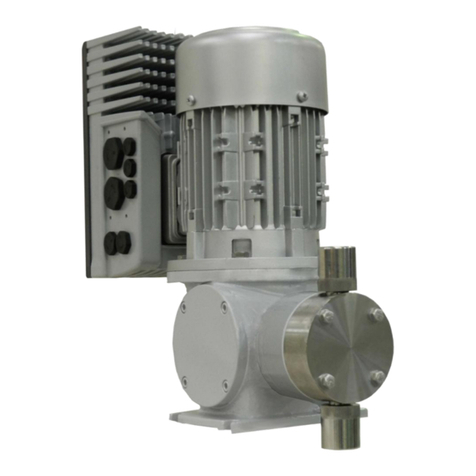
Acromet
Acromet ACRO-SMART AS.1 manual
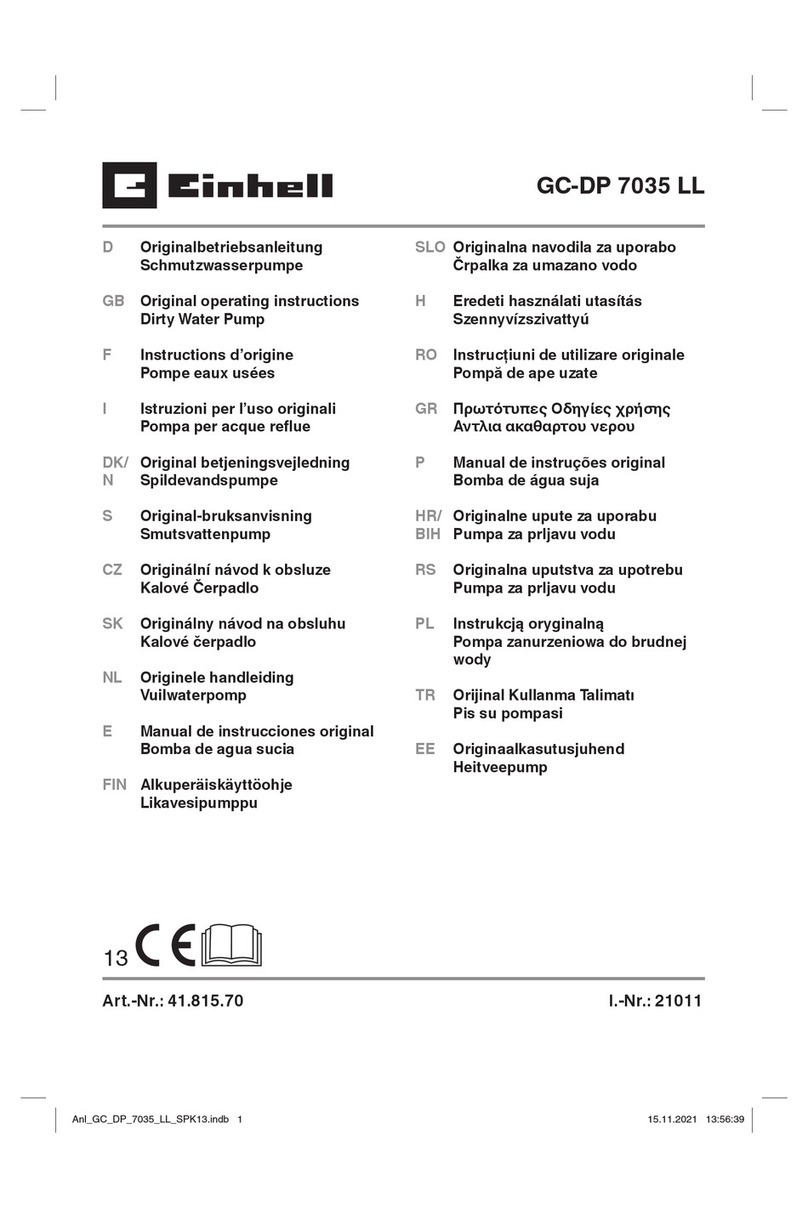
EINHELL
EINHELL GC-DP 7035 LL Original operating instructions

Eurovacuum
Eurovacuum EV Series Installation and operating manual
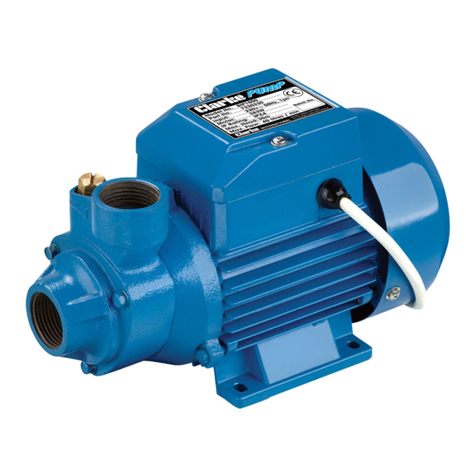
Clarke
Clarke BIP1000 Operation & maintenance instructions
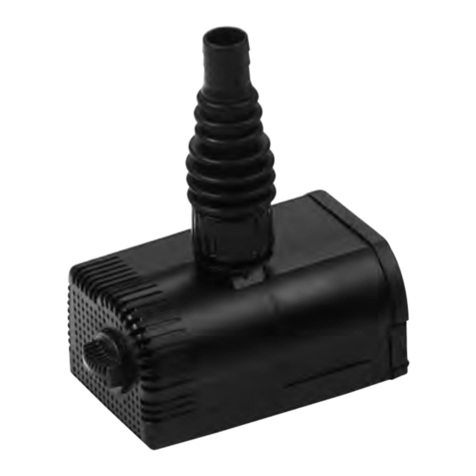
Numa
Numa Oase Aquarius 600 operating instructions

Summit
Summit 2196 model Installation, operation and maintenance manual
